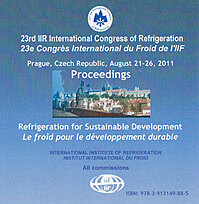
Document IIF
Sécurité industrielle des systèmes frigorifiques à l'ammoniac à efficacité énergétique élevée.
Industrial safety of ammonia systems of cold supplying at high energy efficiency.
Numéro : pap. ID: 292
Auteurs : BELOZEROV G., MEDNIKOVA N., PYTCHENKO V., et al.
Résumé
Inspection of several domestic industrial enterprises showed that majority of enterprises of produce storage exploited the systems with direct ammonia supplying into cooling devices at low level of industrial safety. Some enterprises use systems with cooling batteries for rooms refrigeration that requires more ammonia capacity. Some enterprises use safety systems of indirect refrigeration with coolants; using such systems leads to electric power overrun up to 20%. In most cases it is linked with errors of systems design. The great influence of exploitation factors on electric power overrun was noted, especially presence of air in the systems maintaining the air temperature in rooms lower minus 20°C. It was noted that low temperature processing enterprises begun to use cascade systems operating with CO2 and ammonia that allowed assuring high energy efficiency together with high level of industrial safety. The necessity of control of gas contamination by refrigerants used in the engine-room and technological premises was marked.
Documents disponibles
Format PDF
Pages : 5 p.
Disponible
Prix public
20 €
Prix membre*
Gratuit
* meilleur tarif applicable selon le type d'adhésion (voir le détail des avantages des adhésions individuelles et collectives)
Détails
- Titre original : Industrial safety of ammonia systems of cold supplying at high energy efficiency.
- Identifiant de la fiche : 30001100
- Langues : Anglais
- Sujet : Réglementation
- Source : Proceedings of the 23rd IIR International Congress of Refrigeration: Prague, Czech Republic, August 21-26, 2011. Overarching theme: Refrigeration for Sustainable Development.
- Date d'édition : 21/08/2011
Liens
Voir d'autres communications du même compte rendu (569)
Voir le compte rendu de la conférence
Indexation
-
Thèmes :
Entreposage frigorifique : généralités;
Froid industriel, commercial et domestique : généralités;
Ammoniac;
Réfrigération des aliments;
Congélation des aliments;
Frigorigènes, frigoporteurs : réglementation et normes;
Efficacité energétique, économie d'énergie - Mots-clés : Réglementation; Application industrielle; Sécurité; Ammoniac; Russie; Efficacité énergétique; Frigorigène
-
Industrial chillers with ammonia as refrigerant...
- Auteurs : GERWEN R. van, RAHA S.
- Date : 25/06/2012
- Langues : Anglais
- Source : 10th IIR-Gustav Lorentzen Conference on Natural Working Fluids (GL2012). Proceedings. Delft, The Netherlands, June 25-27, 2012.
- Formats : PDF
Voir la fiche
-
System efficiency index a tool for energy optim...
- Auteurs : BERGLÖF K.
- Date : 12/06/2015
- Langues : Anglais
- Source : Le ultime tecnologie del freddo e del condizionamento. Atti del 16° Convegno Europeo: June 12-13, 2015, Milano, Italia.
- Formats : PDF
Voir la fiche
-
Continuous monitoring of energy performance in ...
- Auteurs : PEARSON A.
- Date : 24/08/2019
- Langues : Anglais
- Source : Proceedings of the 25th IIR International Congress of Refrigeration: Montréal , Canada, August 24-30, 2019.
- Formats : PDF
Voir la fiche
-
CO2 secondary coolant systems: energy efficienc...
- Auteurs : MIKHAILOV A., HEININGEN K. van, KORTSTEE J.
- Date : 21/08/2011
- Langues : Anglais
- Source : Proceedings of the 23rd IIR International Congress of Refrigeration: Prague, Czech Republic, August 21-26, 2011. Overarching theme: Refrigeration for Sustainable Development.
- Formats : PDF
Voir la fiche
-
Transport, Industrial and Commercial Refrigerat...
- Auteurs : MARQUES C., LAGOEIRO H., JANS-SINGH M., MAIDMENT G.
- Date : 21/08/2023
- Langues : Anglais
- Source : Proceedings of the 26th IIR International Congress of Refrigeration: Paris , France, August 21-25, 2023.
- Formats : PDF
Voir la fiche
